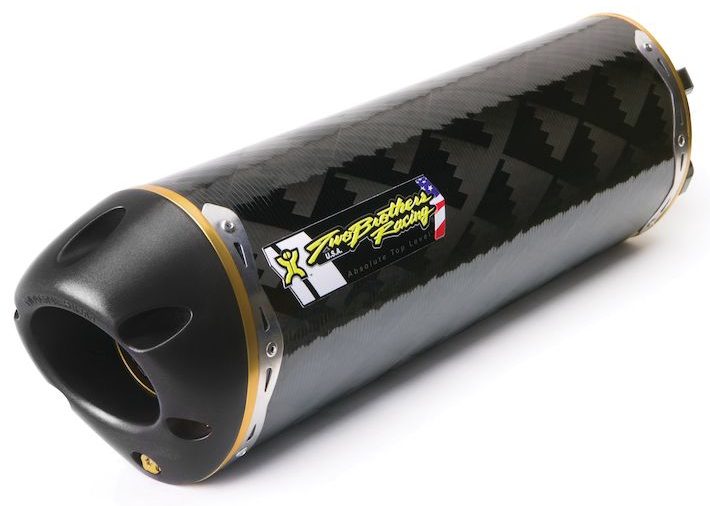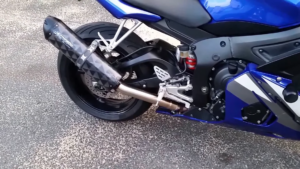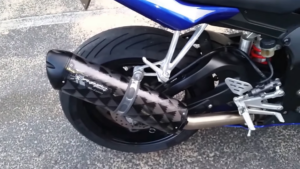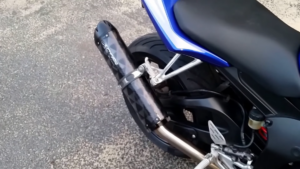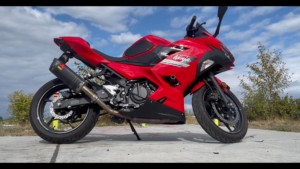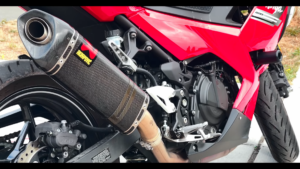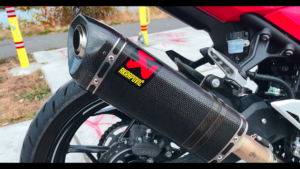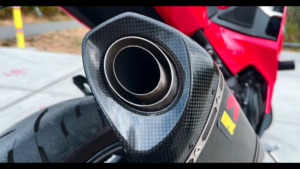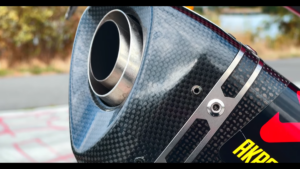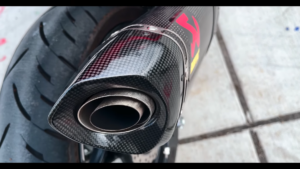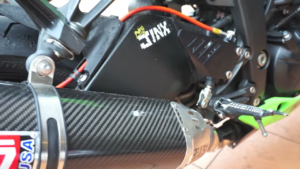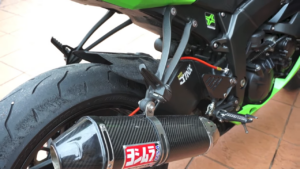When it came time to find the best slip-on exhausts for my Suzuki Hayabusa, I was already armed with a substantial amount of experience in motorcycle exhausts. But I wanted to put my knowledge to the test, and so I compared, researched, and personally tested several options on my Hayabusa.
After an exhaustive review, I was convinced that the Two Brothers M2 Slip-On Exhaust was the superior choice for my bike. Not only was it relatively affordable, but it also brought a deep roar that was a vast improvement over the stock sound.
I was also thrilled to discover the decent weight reductions it offered, making my bike feel more nimble and agile. The performance benefits, particularly in the higher power ranges, were noticeable, too. I felt a real boost when I twisted the throttle.
But what really caught my eye was the appearance of the Two Brothers M2 Slip-On Exhaust. It had a spanking look that added to the aesthetics of my Hayabusa. And when it came to installation, I was pleasantly surprised by how simple and straightforward it was – a true breeze.
The Two Brothers M2 Slip-On Exhaust wasn’t just a purchase; it was a comprehensive upgrade for my bike. If you’re considering something similar for your Hayabusa, I can wholeheartedly recommend it, along with some other top options I found during my research.
Which exhaust turned out to be the lightest among all the ones I tested for my Hayabusa? The one that made a twinge of the throttle create an insatiable roar while maintaining a deep purr at idle? With a super compact design and a perforated core for better sound and gas funneling? It was none other than the Two Brothers M2.
I don’t want to get too carried away, but I must say, this was hands down my favorite slip-on exhaust for the Hayabusa. It was on another level compared to everything else I’ve tinkered with at this price point. Recognizing that most riders, like me, aren’t keen on dropping a grand on a slip-on exhaust, I found the M2 series to be the perfect middle ground.
The sound of the M2 was something special. At idle, it offered a pleasant deep purr that added enjoyment to every red light. Give the throttle a twist, and the M2 opened up with a deep, throaty growl. It was aggressive and loud; definitely not the choice for those seeking something quiet.
What impressed me further was the build quality. The M2 series uses a new patented design known as the V.A.L.E system. It allowed me to attach the muffler to the internal pipes without heavy springs or welding, simplifying the installation and cutting down unnecessary weight.
Constructed entirely from 304 stainless steel, I noticed that it turned a golden amber color after a few rides. A sign of the best quality stainless steel, it reassured me that I had indeed purchased the best.
I tried hard to find flaws in this slip-on exhaust, but it was genuinely difficult to pinpoint anything. It’s positioned in the mid-range of quality exhausts for the Hayabusa, and though not overly expensive, it’s not cheap either. But for me, it was the perfect fit, ticking all the boxes for performance, sound, and aesthetics.
Pros
- Best weight reduction out of everything we tested
- Deep purr at idle
- Sounds great playing with the throttle
- Perforated core
- Superior patented design
- 304 Stainless steel build
- Turns amber colour with use
- Improved torque
- Extra horsepower
- Made in USA
- Compatible with all Hayabusa models
- Easy installation
- One of the loudest slip on exhausts available
Cons
- Pricey
- This exhaust is hard to see on some motorcycle models
When I first laid eyes on Akrapovic’s dual slip-on exhaust for the Hayabusa, I knew I was looking at something special. Designed to make the bike sound like a beast and promising significant power gains, all while keeping it surprisingly lightweight, I couldn’t resist giving it a try. The only pinch was the price tag; after all, I was paying for two slip-ons instead of one.
As I installed it, I realized that the centerpiece of this exhaust system was its style and looks. Most slip-on exhausts tend to blend in, but not these Akrapovic homologated slip-ons. With a dual system that’s right in your face, they made my motorcycle look way cooler. Riding on the road, I felt like a real eye-catcher.
You might think that a dual system would add a lot of weight, but Akrapovic managed to sidestep this issue by using carbon fiber as their primary material. I was surprised to find it was exactly the same weight as the stock exhaust that my Hayabusa came with.
But it wasn’t all sunshine and roses. The downside to carbon fiber is that it’s not the most durable material for an exhaust. I knew that in the case of a crash or if I ever dropped my bike, I might have to replace the exhaust entirely. And with these Akrapovic Homologated Slip-Ons, that would be an expensive replacement.
What really stood out to me during my rides was the performance. While slip-ons aren’t usually known for serious power gains, this dual exhaust was an exception. It was longer than most slip-on alternatives, and with two pipes instead of the usual one, I felt some improvements. Not just at higher speeds, but also in horsepower and a more biting torque.
The experience was thrilling and the sound, the style, and the enhanced performance made me forget about the cost. It was an investment that brought my Hayabusa to life, and I couldn’t have been happier with it.
Pros
- Dual system
- Mostly carbon fibre
- Surprisingly lightweight
- Good power gains
- Classic Akrapovic sound
- Decent torque improvements
- Superior build quality
- Entirely built in house
- By far the coolest looking slip on exhaust
- Overwhelmingly positive customer reviews
- Smoother ride
Cons
- Really expensive
- Not compatible with every Hayabusa model (Check)
When I got my hands on the Yoshimura TRC Slip-On, I knew I was dealing with something that would inject real personality into my Hayabusa motorcycle. From its top-notch build quality to its compact design aimed at reducing weight, I could sense the throaty roar that it promised. It wasn’t exactly a steal, but it fell into a more affordable range, although still on the pricey side.
The TRC stood out among the slip-ons I’d tested, with its uniquely compact design. The triangular sleeve and high-quality stainless steel made it not only lighter than most aftermarket alternatives but also significantly lighter than the stock exhaust on my Hayabusa.
I quickly noticed power gains across the entire rev range, thanks to this weight loss. I could feel how Yoshimura’s internal straight baffle improved the velocity of the gasses produced from the engine, causing noticeable improvements in power gains. However, I had to remind myself that these gains would vary greatly depending on the piping of my bike.
The aesthetics of the Yoshimura TRC were a pleasant surprise. Like most Japanese-style exhausts, the build quality was excellent, and the cone-shaped end cap added a unique touch. The compact design, while functional, did make it look small and inconspicuous, leaving me slightly unsatisfied compared to what a full system exhaust could offer. Still, it was one of the few downsides I found with this slip-on exhaust.
The sound was where the TRC truly won me over. Known for their throaty exhausts, Yoshimura didn’t disappoint with the TRC. It growled at idle and roared to life once I played with the throttle. However, I quickly realized that the sound it produced might be subject to personal preference. It was perfect for me, but it might be wise for others to check first.
Overall, the Yoshimura TRC Slip-On was a thrilling addition to my Hayabusa, marrying aesthetics, performance, and that distinctive sound in a package that felt just right. It brought character and power to my rides, and despite its minor flaws, I found it to be a valuable enhancement for my bike.
Pros
- Great compatibility with the Hayabusa
- Triangular sleeve
- Made from premium stainless steel
- Throaty roar
- Sounds great at idle
- Nice aesthetic
- Designed in Japan produced in the USA
- Carbon fibre end cap
- Decent weight loss
- Good performance gains
- Top notch build quality
- Race exhaust
Cons
- Not super affordable
- Some riders dislike the throaty sound


